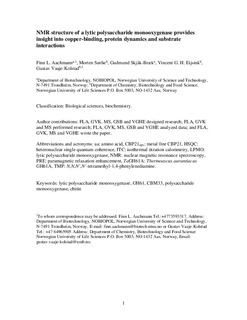| dc.contributor.author | Aachmann, Finn Lillelund | |
| dc.contributor.author | Sørlie, Morten | |
| dc.contributor.author | Skjåk-Bræk, Gudmund | |
| dc.contributor.author | Eijsink, Vincent | |
| dc.contributor.author | Vaaje-Kolstad, Gustav | |
| dc.date.accessioned | 2017-09-04T12:13:44Z | |
| dc.date.available | 2017-09-04T12:13:44Z | |
| dc.date.created | 2012-11-12T23:01:14Z | |
| dc.date.issued | 2012 | |
| dc.identifier.citation | Proceedings of the National Academy of Sciences of the United States of America. 2012, 109 (46), 18779-18784. | nb_NO |
| dc.identifier.issn | 0027-8424 | |
| dc.identifier.uri | http://hdl.handle.net/11250/2453005 | |
| dc.description.abstract | Lytic polysaccharide monooxygenases currently classified as carbohydrate binding module family 33 (CBM33) and glycoside hydrolase family 61 (GH61) are likely to play important roles in future biorefining. However, the molecular basis of their unprecedented catalytic activity remains largely unknown. We have used NMR techniques and isothermal titration calorimetry to address structural and functional aspects of CBP21, a chitin-active CBM33. NMR structural and relaxation studies showed that CBP21 is a compact and rigid molecule, and the only exception is the catalytic metal binding site. NMR data further showed that His28 and His114 in the catalytic center bind a variety of divalent metal ions with a clear preference for Cu2+ (Kd = 55 nM; from isothermal titration calorimetry) and higher preference for Cu1+ (Kd ∼ 1 nM; from the experimentally determined redox potential for CBP21-Cu2+ of 275 mV using a thermodynamic cycle). Strong binding of Cu1+ was also reflected in a reduction in the pKa values of the histidines by 3.6 and 2.2 pH units, respectively. Cyanide, a mimic of molecular oxygen, was found to bind to the metal ion only. These data support a model where copper is reduced on the enzyme by an externally provided electron and followed by oxygen binding and activation by internal electron transfer. Interactions of CBP21 with a crystalline substrate were mapped in a 2H/1H exchange experiment, which showed that substrate binding involves an extended planar binding surface, including the metal binding site. Such a planar catalytic surface seems well-suited to interact with crystalline substrates. | nb_NO |
| dc.language.iso | eng | nb_NO |
| dc.publisher | National Academy of Sciences | nb_NO |
| dc.title | NMR structure of a lytic polysaccharide monooxygenase provides insight into copper binding, protein dynamics, and substrate interactions | nb_NO |
| dc.type | Journal article | nb_NO |
| dc.type | Peer reviewed | nb_NO |
| dc.description.version | acceptedVersion | nb_NO |
| dc.source.pagenumber | 18779-18784 | nb_NO |
| dc.source.volume | 109 | nb_NO |
| dc.source.journal | Proceedings of the National Academy of Sciences of the United States of America | nb_NO |
| dc.source.issue | 46 | nb_NO |
| dc.identifier.doi | 10.1073/pnas.1208822109 | |
| dc.identifier.cristin | 961610 | |
| dc.relation.project | Norges forskningsråd: 214138 | nb_NO |
| dc.relation.project | Norges forskningsråd: 209335 | nb_NO |
| dc.relation.project | Norges forskningsråd: 196885 | nb_NO |
| dc.relation.project | Norges forskningsråd: 182695 | nb_NO |
| dc.relation.project | Norges forskningsråd: 186946 | nb_NO |
| dc.description.localcode | This is the authors' accepted and refereed manuscript to the article. | nb_NO |
| cristin.unitcode | 194,66,15,0 | |
| cristin.unitname | Institutt for bioteknologi | |
| cristin.ispublished | true | |
| cristin.fulltext | postprint | |
| cristin.qualitycode | 2 | |
